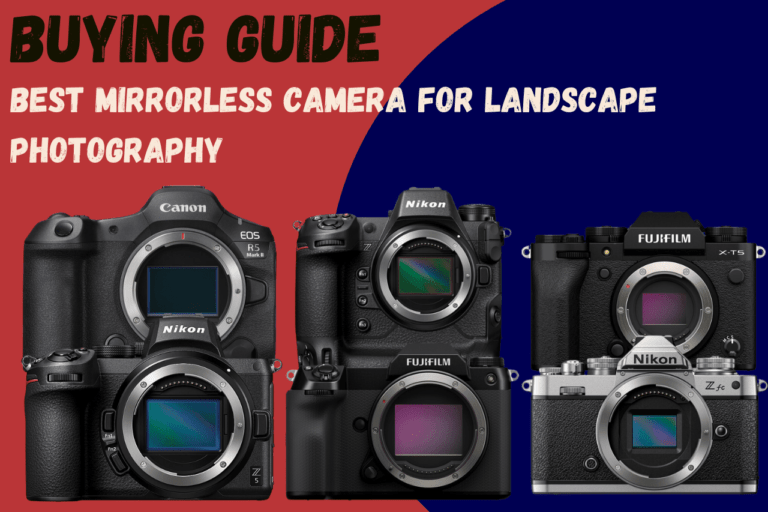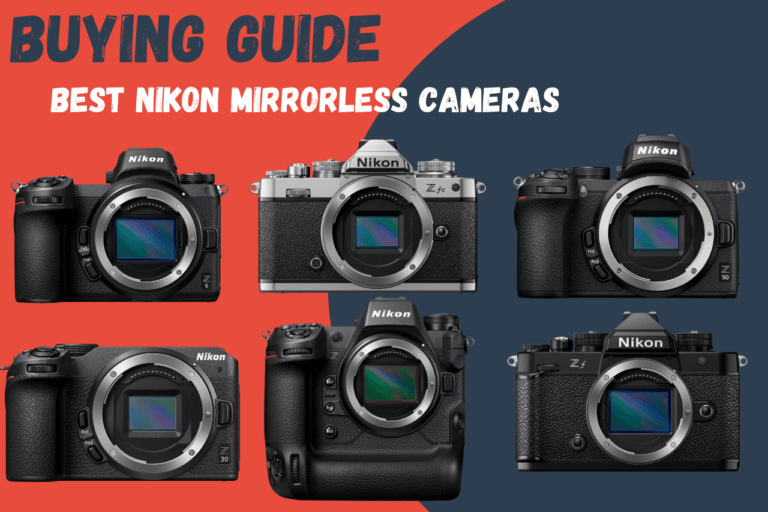Did you know mirrorless camera sales surpassed DSLRs for the first time in 2020?

And the gap only widened since then!
So, whether you’re a beginner looking to buy your first serious camera or a seasoned pro considering a switch, these differences will be crucial to making the right decision. I will discuss the advantages and drawbacks of each system to help you choose the perfect camera for your needs.
Mirrorless vs DSLR: The Basics

Let’s start by quickly going over what’s inside both cameras and how that affects what we’ll discuss later. A DSLR as a camera has a tiny mirror inside. That’s where it gets its name (Digital Single-Lens Reflex).
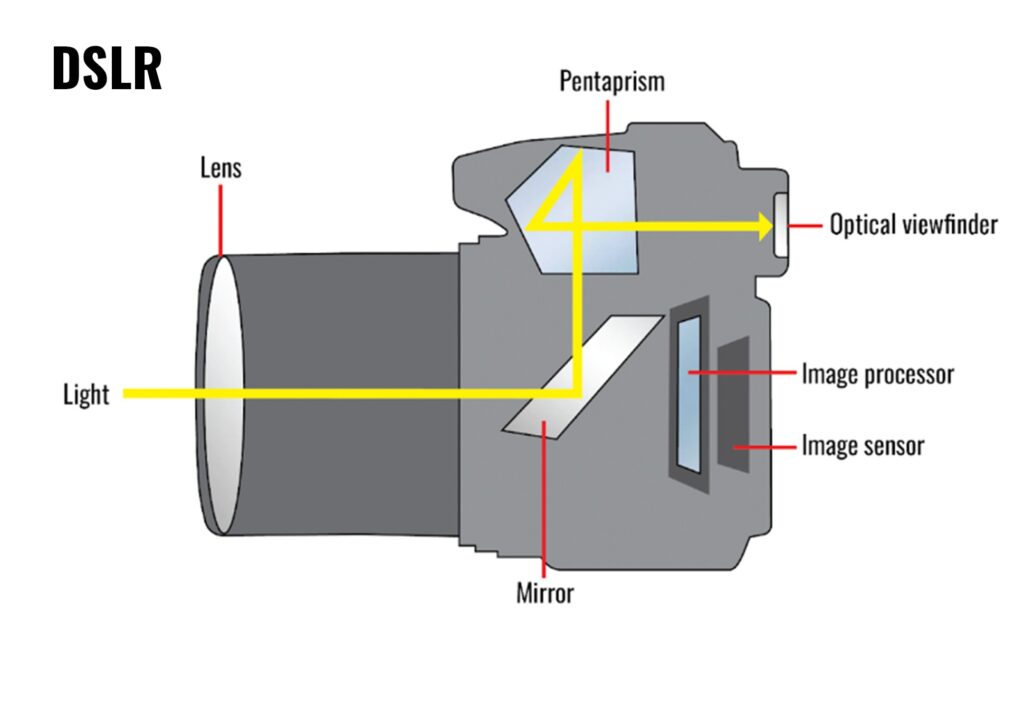
When you look through the viewfinder, you’re seeing exactly what the lens sees thanks to this mirror bouncing light up to your eye. Then, when you press the shutter button, this mirror quickly flips up so light can hit the sensor, and capture your image.
That’s why you might hear a distinctive “clunk” sound when taking photos with a DSLR.
Now, mirrorless cameras? They’re the new kids on the block.
As their name suggests, they ditched the mirror entirely. Instead of using mirrors and prisms to show you what you’re shooting, they use a digital display – kind of like having a super-smart mini TV screen. The camera’s sensor is constantly reading the light coming through the lens and showing you a preview of what your picture will look like.
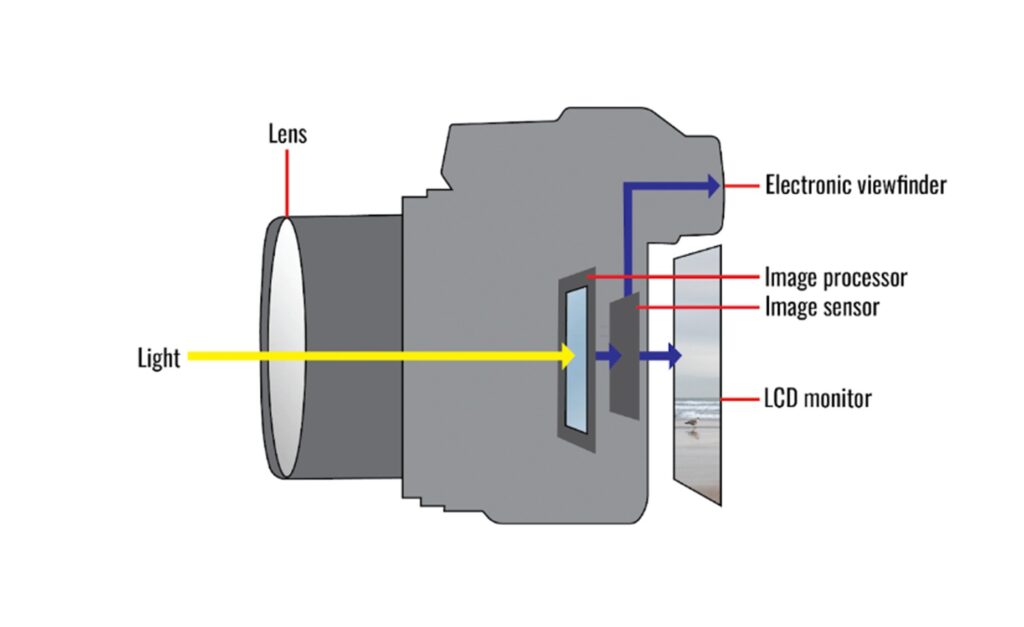
But what do these differences mean when you’re actually out taking photos?
Well, with a DSLR, what you see is 100% real and happening in real-time – there’s no delay because you’re looking through glass and mirrors, and you get that satisfying “click” sound when taking photos (Though some people might not want that! Well, whatever makes you happy).

But to be fair, that mirror mechanism means DSLRs tend to be bigger and heavier, and they are older so the technology is not as sophisticated.
For mirrorless cameras, you can see your exposure settings in real time before you take the shot.
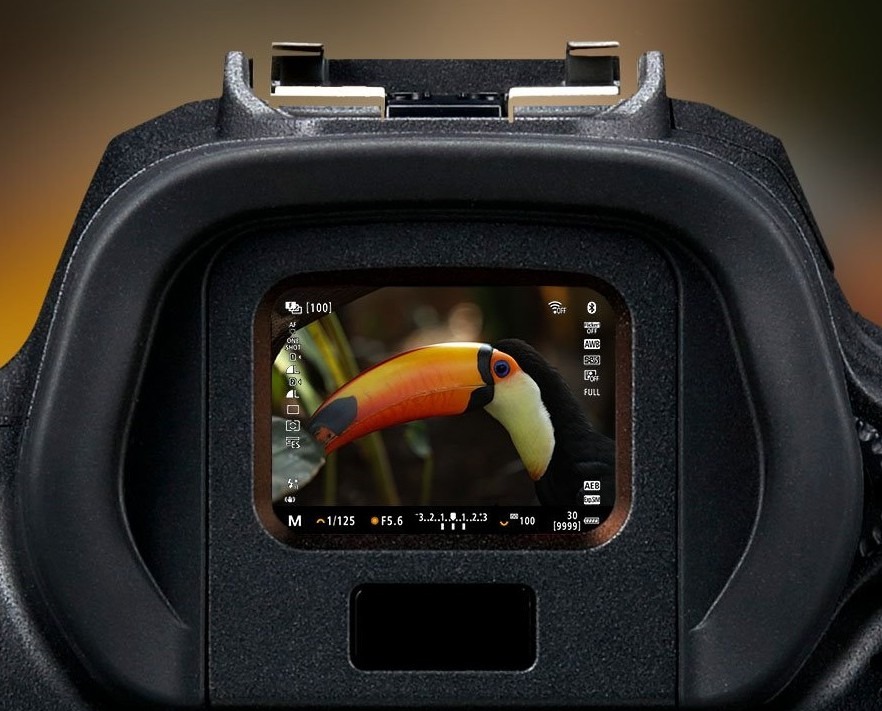
So, what you see is what you get! Also, mirrorless cameras are typically smaller and lighter (great for travel or long shooting days), and they can be completely silent when shooting (perfect for weddings or wildlife).
Mirrorless vs DSLR: 12 Key Differences To Keep In Mind
What I said earlier was the short answer for people who don’t want to stick around to read the whole thing, although:

But if you are, let’s get ready to go over all the differences with a fine tooth comb.
Size and Weight
One of the biggest differences between mirrorless and DSLR cameras is their physical size. Mirrorless cameras are typically more compact and lighter – that’s because they don’t need space for that mirror mechanism I mentioned earlier.

Most mirrorless bodies are about 30% smaller and lighter than their DSLR counterparts. For example, Sony’s a7C mirrorless camera weighs just 509g, while the similar DSLR Nikon D780 weighs 840g. That 331g difference might not sound like much on paper, but you’ll definitely feel it after a long day of shooting or while hiking to capture landscapes!
View Finder: Optical vs. Electronic
Let’s discuss how you see your shots. DSLRs use an optical viewfinder (OVF) with the mirror system we discussed. It shows you exactly what the lens sees in real-time, with no lag or battery drain.

Mirrorless cameras, however, use an electronic viewfinder (EVF), which is essentially a tiny, high-resolution screen. Fun fact, early EVFs were pretty laggy, and people used to make fun of them.
But, modern ones are incredibly responsive with refresh rates up to 120fps. The big advantage? EVFs show you exactly how your photo will look before you take it, including exposure, white balance, and creative effects. So, you never have to worry about a shot being under or overexposed.
Sensor Technology
The difference here isn’t the sensor itself, but how it’s used.

Let me explain!
Mirrorless cameras use their sensors for both viewing and shooting, while DSLRs only use them when taking photos.

This links directly to the point of seeing your shots in real-time using a DSLR’s OVF (since the sensor only works when you take the shot) vs. seeing how your shots are exposed before taking them with an EVF.
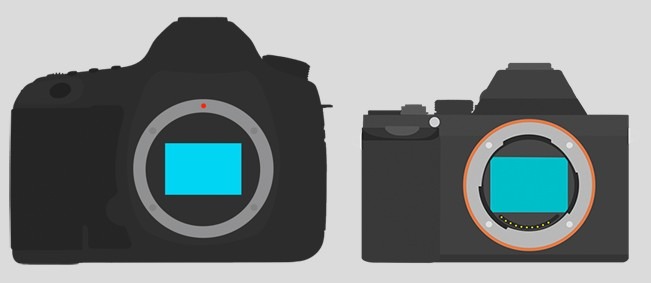
For the resolution, DSLRs still give you great resolution – we’re talking 45+ megapixels in high-end models – and excellent high ISO performance up to 12,800 and beyond.
But, in-body image stabilization (IBIS) is more common in mirrorless cameras (which we will talk about later on), though some newer DSLRs have it too.
Autofocus Performance and Speed
Here’s where things get interesting!
They excel at features like eye-detection AF and subject tracking because they’re using the main imaging sensor for focus. DSLRs use a separate phase-detection AF sensor that’s fast but usually has fewer focus points concentrated in the center of the frame.

Modern mirrorless cameras typically have more advanced autofocus systems, with up to 1000+ focus points covering nearly the entire frame.
In real-world use, both systems can focus incredibly quickly in good light. But mirrorless cameras tend to have an edge in low light, and for tracking moving subjects. Features like eye AF that can follow a subject’s eye even as they move around the frame, which makes it a great choice for wildlife photographers and videographers.
Continuous Shooting
When it comes to capturing fast action, DSLRs can’t compete with mirrorless cameras. New models blow DSLRs out of the water, with some capable of shooting up to 30 frames per second using the electronic shutter (incredible for sports or wildlife photography).

Take the Sony A1 for example – it can shoot 30fps at full resolution, or the Canon R3 and Nikon Z9 that can hit 20fps.
In comparison, even professional DSLRs like the Canon 1DX Mark III or Nikon D6 typically max out around 12-14 fps, though that’s still plenty fast for most situations.
However, using these high-speed electronic shutters can cause what’s called a rolling shutter effect. This happens when the sensor reads data line by line rather than all at once, which can cause fast-moving subjects or quick camera movements to appear distorted.

This is where DSLRs have a slight advantage – their mechanical shutters capture the entire frame at once, eliminating the rolling shutter effect.
The problem? Mechanical shutters are louder and have more physical wear and tear because of their moving parts. So, most modern cameras offer both options, this way you can choose between electronic shooting or mechanical shutter depending on your needs.
Image Quality

A lot of people will confuse you with the technical gibberish about mirrorless cameras when it comes to image quality, but here’s the truth:

So both of them will produce stunning photos with excellent dynamic range (typically 14+ stops in modern full-frame sensors) and rich color depth.
The actual difference you’ll see in your photos will come more from your lens choice and shooting technique, than from whether you’re using a mirrorless or DSLR camera.
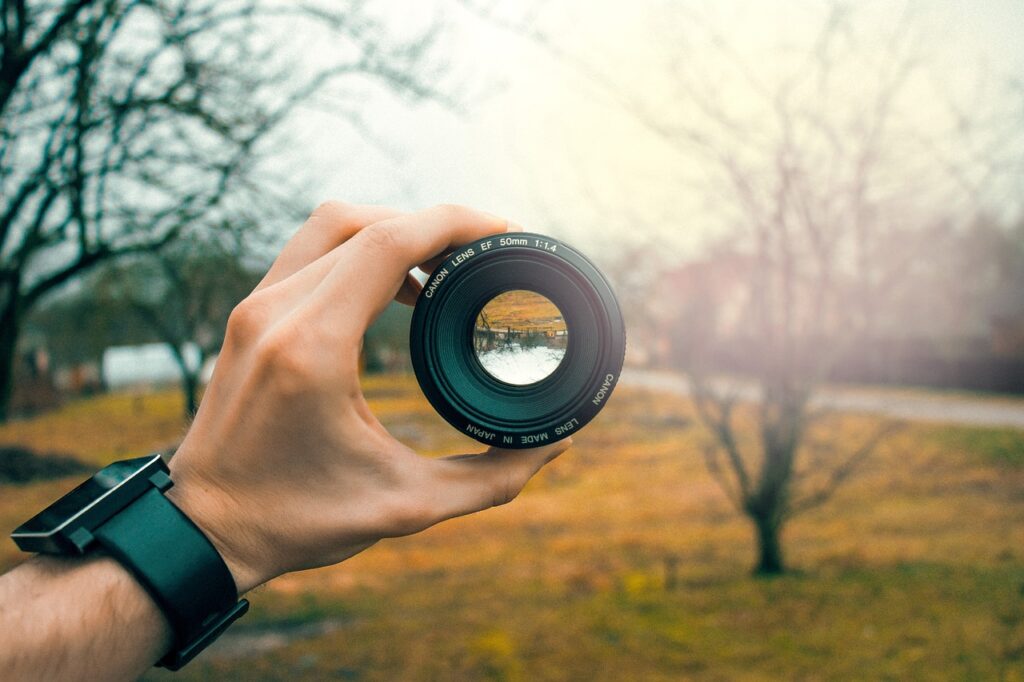
Lens Selection and Compatibility
DSLRs have a huge advantage here simply because they’ve been around longer – we’re talking decades of lens development.

However, mirrorless systems are catching up remarkably quickly. Companies like Sony, Canon, and Nikon now offer extensive mirrorless lens lineups, and they tend to be incredibly sharp, though often more expensive than their DSLR counterparts.
The good news? Most manufacturers offer adapters that let you use DSLR lenses on mirrorless bodies (but the opposite is not true), often with full autofocus and image stabilization support.
We can argue that adapted lenses focus slightly slower than native ones, but this compatibility is still good because it means you’re not starting from scratch if you decide to switch systems.
New Features
Now to the good stuff! Mirrorless cameras revolutionized the way we capture images with things that were either impossible or impractical in traditional DSLR designs.

In-body image stabilization, for example, became a game-changer. You can now shoot handheld at significantly slower shutter speeds with any lens mounted to the camera.

Yep! This technology works by shifting the sensor to compensate for camera movement, and that gives you up to 8 stops of stabilization in the latest models – shooting a sharp image at 1/8th of a second handheld!
Another thing is eye detection and subject tracking capabilities. Unlike DSLRs, which typically focus using a separate sensor, mirrorless cameras use their main imaging sensor for autofocus, this way you can track subjects across virtually the entire frame.
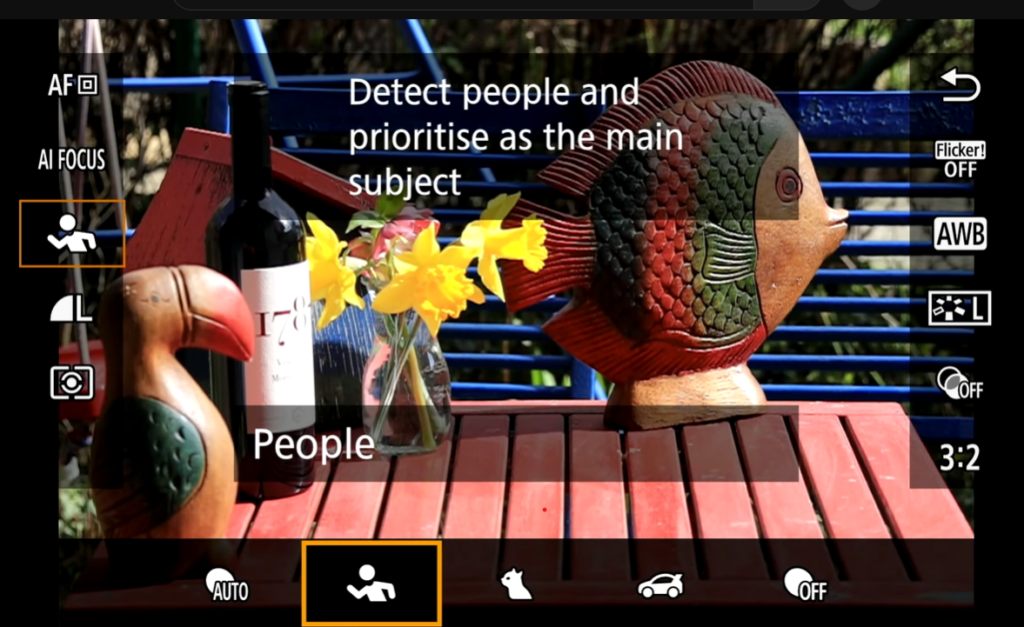
This technology can recognize and track not just human eyes but also those of animals and birds, making wildlife photography more accessible than ever.
Silent shooting, enabled by fully electronic shutters, also opened up new possibilities for weddings, events, and wildlife photography. You can now approach skittish wildlife without making a sound.
Combine that with zebra patterns that show exposure information in real-time, through the electronic viewfinder, you can now work with unprecedented precision and confidence.
Video Features and Performance
This one goes hands down to mirrorless cameras. The electronic viewfinder and continuous sensor readout make them natural hybrid cameras. 4K video quality is now a norm, with many models capable of internal 10-bit 4:2:2 recording – a level of quality that was once reserved for dedicated cinema cameras.

Autofocus during video recording is also spotless with mirrorless technology. The same on-sensor phase-detection points used for photography now enable smooth, cinematic focus transitions and reliable subject tracking. You can say goodbye to the days of hunting for focus or losing your subject during critical moments.

They also offer high frame rate recording for slow-motion footage, with some capable of 4K at 120fps or even higher speeds at lower resolutions.
Plus, if you want to color grade, you can choose between different Log profiles and HDR video options while shooting to capture more dynamic range and color information.
Let’s not forget the new kid on the block! Artificial Intelligence.

Well until that day happens, let’s use it.
So, with the AI revolution, many models offer AI-powered subject recognition that can maintain focus on faces, eyes, or specified objects even as they move through the frame.

However. heat management remains a consideration, particularly for extended recording sessions.
But you don’t have to worry about it. Some camera manufacturers are now using active cooling systems or implementing sophisticated heat dissipation designs. Sure, DSLRs might handle heat better due to their larger bodies (and shallow inside).

That sounded like an insult! But it really isn’t.
Anyway, the video capability of mirrorless cameras more than makes up for the heating problem for most videographers.
Battery Life and Power Management
This is where DSLRs shine – their optical viewfinders use minimal power, so they can often shoot 800-1000+ shots per charge.

On the other hand, Mirrorless cameras are constantly powering their electronic viewfinders and sensors. So, they typically manage 300-400 shots per battery. However, most photographers rarely shoot that many photos in one session, and if you do, solutions like battery grips, USB charging, and power banks make this less of an issue than it used to be.
Collecting and Cleaning Dust
This is an issue that’s usually overlooked, but very important. Mirrorless cameras have a slight disadvantage here (or an advantage, depending on how you see it).

Their sensors are closer to the lens mount, which makes them more susceptible to dust. However, sensor cleaning for DSLRs was a nightmare for most people because the sensor is hidden behind the mirror and shutter.
So, it’s up to you to choose which one to go with here, especially since both systems gather dust during lens changes. Not to mention that most modern cameras have automatic sensor cleaning systems, and manual cleaning isn’t difficult with the right tools.
(For mirrorless cameras, for DSLRs, It is!)

Price and Value Considerations
The last point, and frankly the most important one for a beginner: The cost. Well, we can say that this point goes to DSLRs.

Entry-level DSLRs are typically more affordable, starting around $500 with a kit lens, compared to mirrorless cameras that usually start at $700-800.
However, when you move into professional territory, prices even out. The real cost consideration comes with lenses – mirrorless lenses tend to be more expensive, though they often deliver superior optical performance.
Also, you can always go with the used market, where you can find great deals for DSLRs as many photographers are switching to mirrorless. but, I should mention that used mirrorless equipment tends to hold its value better. So, I guess it’s a draw on this one. Hm!
The verdict
Well, that sounds very serious.

Just kidding! Well, frankly, the choice between a mirrorless and a DSLR camera really depends on your specific photography needs, preferences, AND budget.
(For videographers, I wouldn’t think about a DSLR if you want something for professional shooting. For personal use though, you can still use it to learn the basics and improve your skills).
But overall, mirrorless cameras lead in technology and represent the future of photography, where DSLRs offer compelling advantages in battery life and value. So, consider your priorities in terms of size, performance, and budget when making your decision. Once you feel it’s time for an upgrade, you can always use a lens adapter to take your lenses with you to the new system.
Remember: The best camera is the one you use confidently to tell your story!
